Virginia Woolf and E. M. Forster - 副本
- 格式:doc
- 大小:149.50 KB
- 文档页数:31
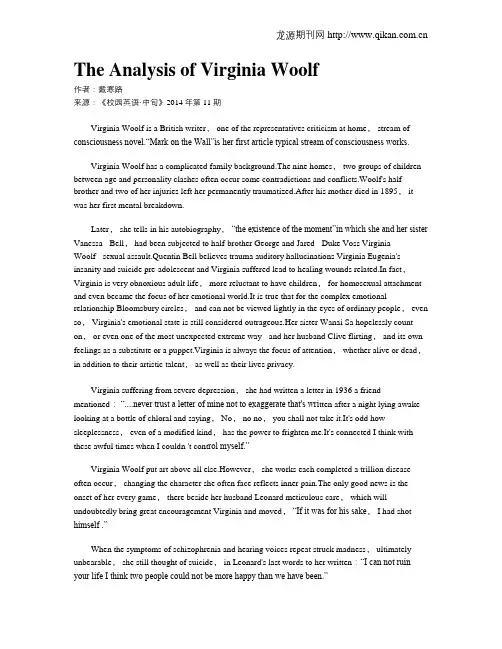
The Analysis of Virginia Woolf作者:戴寒路来源:《校园英语·中旬》2014年第11期Virginia Woolf is a British writer, one of the representatives criticism at home, stream of consciousness novel.“Mark on the Wall”is her first article typical stream of consciousness works.Virginia Woolf has a complicated family background.The nine homes, two groups of children between age and personality clashes often occur some contradictions and conflicts.Woolf's half-brother and two of her injuries left her permanently traumatized.After his mother died in 1895, it was her first mental breakdown.Later, she tells in his autobiography,“the existence of the moment”in which she and her sister Vanessa · Bell, had been subjected to half-brother George and Jared · Duke Voss VirginiaWoolf · sexual assault.Quentin Bell believes trauma auditory hallucinations Virginia Eugenia's insanity and suicide pre-adolescent and Virginia suffered lead to healing wounds related.In fact,Virginia is very obnoxious adult life, more reluctant to have children, for homosexual attachment and even became the focus of her emotional world.It is true that for the complex emotional relationship Bloomsbury circles, and can not be viewed lightly in the eyes of ordinary people, even so, Virginia's emotional state is still considered outrageous.Her sister Wanai Sa hopelessly count on, or even one of the most unexpected extreme way - and her husband Clive flirting, and its own feelings as a substitute or a puppet.Virginia is always the focus of attention, whether alive or dead,in addition to their artistic talent, as well as their lives privacy.Virginia suffering from severe depression, she had written a letter in 1936 a friend mentioned:“....never trust a letter of mine not to exaggerate that's wri tten after a night lying awake looking at a bottle of chloral and saying, No, no no, you shall not take it.It's odd how sleeplessness, even of a modified kind, has the power to frighten me.It's connected I think with these awful times when I couldn 't cont rol myself.”Virginia Woolf put art above all else.However, she works each completed a trillion disease often occur, changing the character she often face reflects inner pain.The only good news is the onset of her every game, there beside her husband Leonard meticulous care, which will undoubtedly bring great encouragement Virginia and moved,“If it was for his sake, I had shot himself .”When the symptoms of schizophrenia and hearing voices repeat struck madness, ultimately unbearable, she still thought of suicide, in Leonard's last words to her written:“I can not ruin your life I think two people could not be more happy than we have been.”Woolf was the first to put forward the “androgyny” feminists.She abandoned the meaning of biol ogy and psychology played an implication on.She borrowed “androgyny”explores the planing for the question:“In each of us there are two forces dictate everything So it seems.Woolf advocated is actually an ideal literary mind that gender is completely platform for harmonious co-existence of the realm is the gist of her poetic theory.But she thinks because of women's unique experience,experience - pregnancy,childbirth.“Sense”that women are bisexual '; men - everyone knows - is poised to maintain the glory o f men worship a single viewpoint.”Androgyny is not particularly sharp against the city.Does not exclude any one of, Can communicate with each other inspired by the huge enclosed force.But she mystification for the female body.As well as “female writing” over-sharing Chong.Have preached the dangers of female supremacy.Although the long-term resistance meter people writing theory Woolf “androgyny”multi-controversial.But it is undeniable yes.Woolf advocated male writers and female writers must transcend gender identity and writing.Has its forward-thinking and unique significance.From this point of view.Mrs.Wolf is undoubtedly great.Among the many works of Woolf's “Orlando”is undoubtedly different.Its “androgyny” typical creative concept.1925 or so.Prod uced some unusual friendship between Woolf and 薇塔.This is perhaps a kind Woolf “androgyny”personal experience.1928.Woolf to cut the tower because of being female and five suffered ancestral estate law get inheritance rights for the material.Written a humorous light fantasy novel - “Orlando.”Unique address of the novel is that it across time and space and gender barriers.References:[1]Wang Hung stream:“On Woolf's androgyny feminism”,“Journal of theNortheast”September 2010 fifth.。
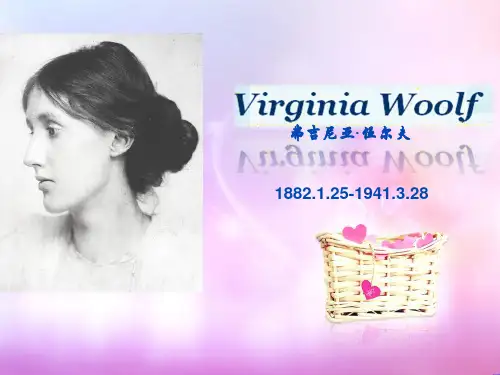
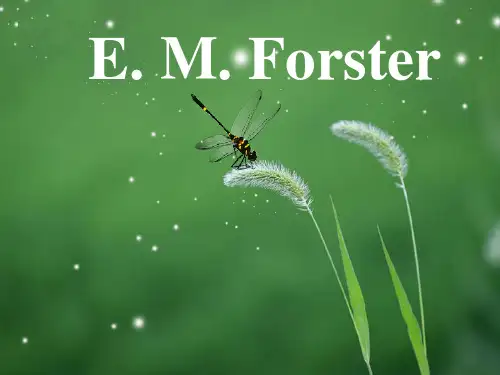
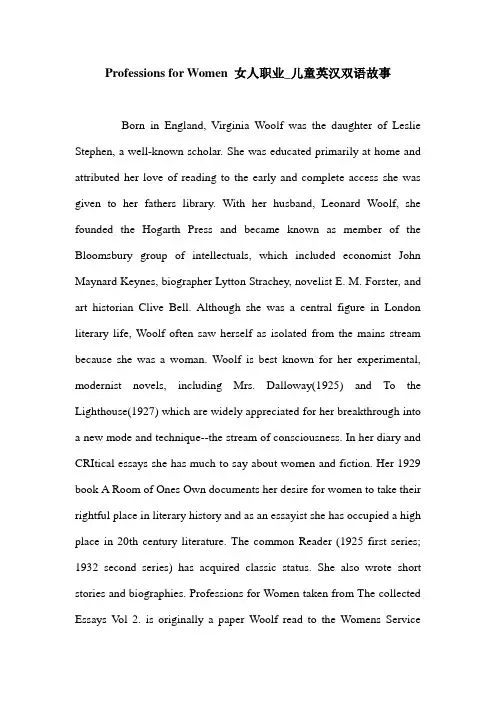
Professions for Women 女人职业_儿童英汉双语故事Born in England, Virginia Woolf was the daughter of Leslie Stephen, a well-known scholar. She was educated primarily at home and attributed her love of reading to the early and complete access she was given to her fathers library. With her husband, Leonard Woolf, she founded the Hogarth Press and became known as member of the Bloomsbury group of intellectuals, which included economist John Maynard Keynes, biographer Lytton Strachey, novelist E. M. Forster, and art historian Clive Bell. Although she was a central figure in London literary life, Woolf often saw herself as isolated from the mains stream because she was a woman. Woolf is best known for her experimental, modernist novels, including Mrs. Dalloway(1925) and To the Lighthouse(1927) which are widely appreciated for her breakthrough into a new mode and technique--the stream of consciousness. In her diary and CRItical essays she has much to say about women and fiction. Her 1929 book A Room of Ones Own documents her desire for women to take their rightful place in literary history and as an essayist she has occupied a high place in 20th century literature. The common Reader (1925 first series; 1932 second series) has acquired classic status. She also wrote short stories and biographies. Professions for Women taken from The collected Essays V ol 2. is originally a paper Woolf read to the Womens ServiceLeague, an organization for professional women in London.When your secretary invited me to come here, she told me that your Society is concerned with the employment of women and she suggested that I might tell you something about my own professional experiences. It is true that I am a woman; it is true I am employed; but what professional experiences have I had? It is difficult to say. My profession is literature; and in that profession there are fewer experiences for women than in any other, with the exception of the stage--fewer, I mean, that are peculiar to women. For the road was cut many years ago---by Fanny Burney, by Aphra Behn, by Harriet Martineau, by Jane Austen, by George Eliot many famous women, and many more unknown and forgotten, have been before me, making the path smooth, and regulating my steps. Thus, when I came to write, there were very few material obstacles in my way. Writing was a reputable and harmless occupation. The family peace was not broken by the scratching of a pen. No demand was made upon the family purse. For ten and sixpence one can buy paper enough to write all the plays of Shakespeare--if one has a mind that way. Pianos and models, Paris, Vienna, and Berlin, masters and mistresses, are not needed by a writer. The cheapness of writing paper is, of course, the reason why women have succeeded as writers before they have succeeded in the other professions.But to tell you my story--it is a simple one. You have only got tofigure to yourselves a girl in a bedroom with a pen in her hand. She had only to move that pen from left to right--from ten oclock to one. Then it occurred to her to do what is simple and cheap enough after all--to slip a few of those pages into an envelope, fix a penny stamp in the corner, and drop the envelope into the red box at the corner. It was thus that I became a journalist; and my effort was rewarded on the first day of the following month--a very glorious day it was for me--by a letter from an editor containing a check for one pound ten shillings and sixpence. But to show you how little I deserve to be called a professional woman, how little I know of the struggles and difficulties of such lives, I have to admit that instead of spending that sum upon bread and butter, rent, shoes and stockings, or butchers bills, I went out and bought a cat--a beautiful cat, a Persian cat, which very soon involved me in bitter disputes with my neighbors.What could be easier than to write articles and to buy Persian cats with the profits? But wait a moment. Articles have to be about something. Mine, I seem to remember, was about a novel by a famous man. And while I was writing this review, I discovered that if I were going to review books I should need to do battle with a certain phantom. And the phantom was a woman, and when I came to know her better I called her after the heroine of a famous poem, The Angel in the House. It was she who used to come between me an my paper when I was writing reviews.It was she who bothered me and wasted my time and so tormented me that at last I killed her. You who come off a younger and happier generation may not have heard of her--you may not know what I mean by The Angel in the House. I will desCRIbe her as shortly as I can. She was intensely sympathetic. She was immensely charming. She was utterly unselfish. She excelled in the difficult arts of family life. She saCRIficed herself daily. If there was chicken, she took the leg; if there was a draft she sat in it--in short she was so constituted that she never had a mind or a wish of her own, but preferred to sympathize always with the minds and wishes of others. Above all--I need not say it--she was pure. Her purity was supposed to be her chief beauty--her blushes, her great grace. In those days--the last of Queen Victoria--every house had its Angel. And when I came to write I encountered her with the very first words. The shadow of her wings fell on my page; I heard the rustling of her skirts in the room. Directly, that is to say, I took my pen in my hand to review that novel by a famous man, she slipped behind me and whispered:My dear, you are a young woman. You are writing about a book that has been written by a man. Be sympathetic; be tender; flatter; deceive; use all the art and wiles of our sex. Never let anybody guess that you have a mind of our own. Above all, be pure. And she made as if to guide my pen. I now record the one act for which I take some credit to myself, though the credit rightly belongs to some excellent ancestors of mine who left me acertain sum of money--shall we say five hundred pounds a year? --so that it was not necessary for me to depend solely on charm for my living. I turned upon her and caught her by the throat. I did my best to kill her. My excuse, If I were to be had up in a court of law, would be that I acted in self-defense. Had I not killed her she would have killed me. She would have plucked the heart out of my writing. For, as I found, directly I put pen to paper, you cannot review even a novel without having a mind of your own, without expressing what you think to be the truth about human relations, morality, sex. And all these questions, according to the Angel of the House, cannot be dealt with freely and openly by women; they must charm, they must conciliate, they mustto put it bluntly-tell lies if they are to succeed. Thus, whenever I felt the shadow of her wing or the radiance of her halo upon my page, I took up the inkpot and flung it at her. She died hard. Her fictitious nature was of great assistance to her. It is far harder to kill a phantom than a reality. She was always creeping back when I thought I had dispatched her. Though I flatter myself that I killed her in the end, the struggle was severe; it took much time that had better have been spent upon learning Greek grammar; or in roaming the world in search of adventures. But it was a real experience; It was an experience that was bound befall all women writers at that time. Killing the Angel in the House was part of the occupation of a woman writer.But to continue my story. The Angel was dead; what then remained?You may say that what remained was a simple and common object--a young woman in a bedroom with an inkpot. In other words, now that she had rid herself of falsehood, that young woman had only to be herself. Ah, but what is herself? I mean, what is a woman? I assure you, I do not know.I do not believe that you know. I do not believe that anybody can know until she has expressed herself in all the arts and professions open to human skill. That indeed is one of the reasons why I have come here--out of respect for you, who are in process of showing us by your experiments what a woman is, who are in process of providing us, by your failures and succeeded, with that extremely important piece of information.But to continue the story of my professional experiences. I made one pound ten and six by my first review; and I bought a Persian cat with the proceeds. Then I grew ambitious. A Persian cat is all very well, I said; but a Persian cat is not enough. I must have a motorcar. And it was thus that I became a novelist--for it is a very strange thing that people will give you a motorcar if you will tell them a story. It is a still stranger thing that there is nothing so delightful in the world as telling stories. It is far pleasanter than writing reviews of famous novels. And yet, if I am to obey your secretary and tell you my professional experiences as a novelist, I must tell you about a very strange experience that befell me as a novelist. And to understand it you must try first to imagine a novelists state of mind. I hope I am not giving away professional secrets if I say that a novelistschief desire is to be as unconscious as possible. He has to induce in himself a state of perpetual lethargy. He wants life to proceed with the utmost quiet and regularity. He wants to see the same faces, to read the same books, to do the same things day after day, month after month, while he is writing, so that nothing may break the illusion in which he is living--so that nothing may disturb or disquiet the mysterious nosings about, feelings round, darts, dashes, and sudden discoveries of that very shy and illusive spirit, the imagination. I suspect that this state is the same both for men and women. Be that as it may, I want you to imagine me writing a novel in a state of trance. I want you to figure to yourselves a girl sitting with a pen in her hand, which for minutes, and indeed for hours, she never dips into the inkpot. The image that comes to my mind when I think of this girl is the image of a fisherman lying sunk in dreams on the verge of a deep lake with a rod held out over the water. She was letting her imagination sweep unchecked round every rock and cranny of the world that lies submerged in the depths of our unconscious being. Now came the experience that I believe to be far commoner with women writers than with men. The line raced through the girls fingers. Her imagination had rushed away. It had sought the pools, the depths, the dark places where the largest fish slumber. And then there was a smash. There was an explosion. There was foam and confusion. The imagination had dashed itself against something hard. The girl was roused from her dream.She was indeed in a state of the most acute and difficult distress. To speak without figure, she had thought of something, something about the body, about the passions which it was unfitting for her as a woman to say. Men, her reason told her, would be shocked. The consciousness of what men will say of a woman who speaks the truth about her passions had roused her from her artists state of unconsciousness. She could write no more. The trace was over. Her imagination could work no longer. This I believe to be a very common experience with women writers--they are impeded by the extreme conventionality of the other sex. For though men sensibly allow themselves great freedom in these respects, I doubt that they realize or can control the extreme severity with which they condemn such freedom in women.These then were two very genuine experiences of my own. These were two of the adventures of my professional life. The first--killing the Angel in the House--I think I solved. She died. But the second, telling the truth about my own experiences as a body, I do not think I solved. I doubt that any woman has solved it yet. The obstacles against her are still immensely powerful--and yet they are very difficult to define. Outwardly, what is simpler than to write books? Outwardly, what obstacles are there for a woman rather than for a man? Inwardly, I think, the case is very different; she has still many ghosts to fight, many prejudices to overcome. Indeed it will be a long time still, I think, before a woman can sit down towrite a book without finding a phantom to be slain, a rock to be dashed against. And if this is so in literature, the freest of all professions for women, how is it in the new professions which you are now for the first time entering?Virginia Woolf。
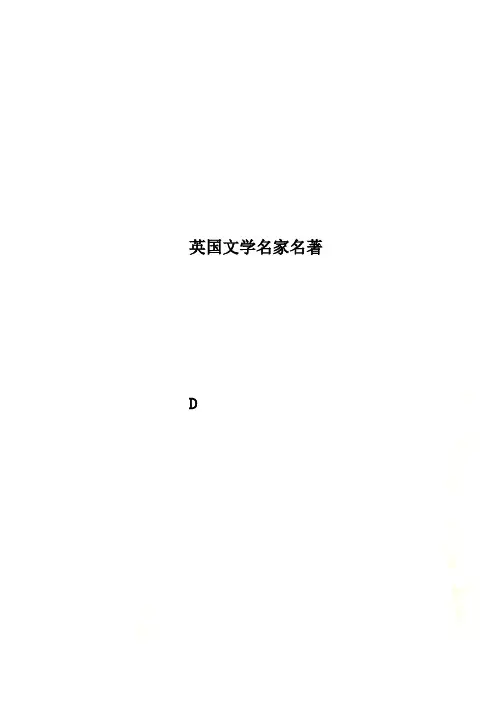
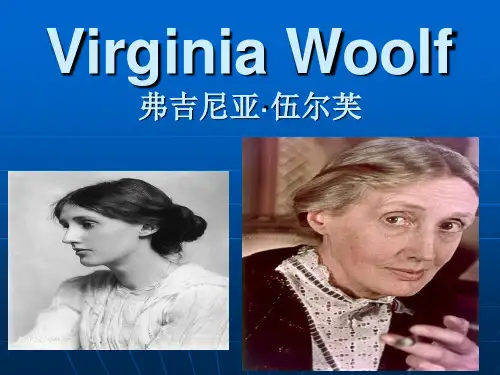
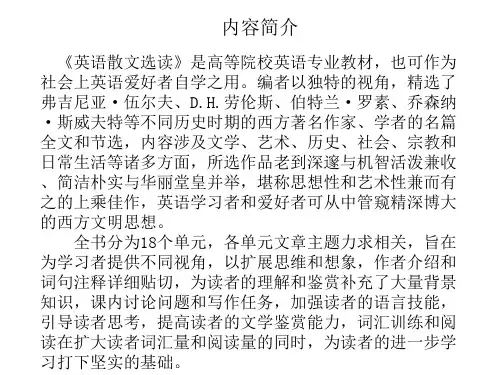
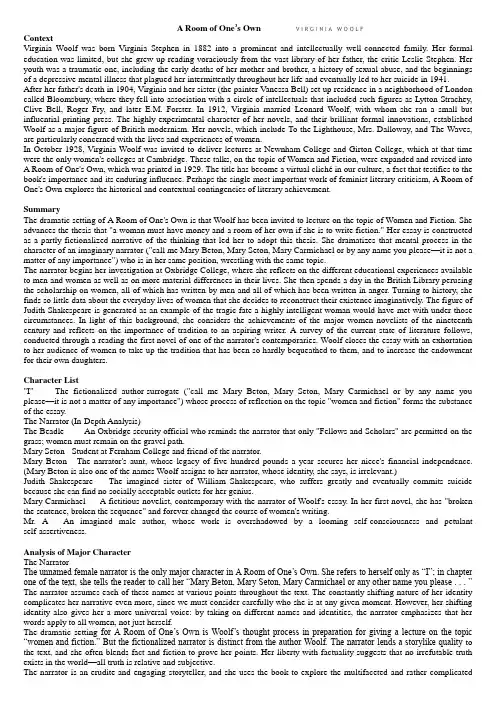
A Room of One’s Own V I R G I N I A W O O L FContextVirginia Woolf was born Virginia Stephen in 1882 into a prominent and intellectually well-connected family. Her formal education was limited, but she grew up reading voraciously from the vast library of her father, the critic Leslie Stephen. Her youth was a traumatic one, including the early deaths of her mother and brother, a history of sexual abuse, and the beginnings of a depressive mental illness that plagued her intermittently throughout her life and eventually led to her suicide in 1941. After her father's death in 1904, Virginia and her sister (the painter Vanessa Bell) set up residence in a neighborhood of London called Bloomsbury, where they fell into association with a circle of intellectuals that included such figures as Lytton Strachey, Clive Bell, Roger Fry, and later E.M. Forster. In 1912, Virginia married Leonard Woolf, with whom she ran a small but influential printing press. The highly experimental character of her novels, and their brilliant formal innovations, established Woolf as a major figure of British modernism. Her novels, which include To the Lighthouse, Mrs. Dalloway, and The Waves, are particularly concerned with the lives and experiences of women.In October 1928, Virginia Woolf was invited to deliver lectures at Newnham College and Girton College, which at that time were the only women's colleges at Cambridge. These talks, on the topic of Women and Fiction, were expanded and revised into A Room of One's Own, which was printed in 1929. The title has become a virtual cliché in our culture, a fact that testifies to the book's importance and its enduring influence. Perhaps the single most important work of feminist literary criticism, A Room of One's Own explores the historical and contextual contingencies of literary achievement.SummaryThe dramatic setting of A Room of One's Own is that Woolf has been invited to lecture on the topic of Women and Fiction. She advances the thesis that "a woman must have money and a room of her own if she is to write fiction." Her essay is constructed as a partly-fictionalized narrative of the thinking that led her to adopt this thesis. She dramatizes that mental process in the character of an imaginary narrator ("call me Mary Beton, Mary Seton, Mary Carmichael or by any name you please—it is not a matter of any importance") who is in her same position, wrestling with the same topic.The narrator begins her investigation at Oxbridge College, where she reflects on the different educational experiences available to men and women as well as on more material differences in their lives. She then spends a day in the British Library perusing the scholarship on women, all of which has written by men and all of which has been written in anger. Turning to history, she finds so little data about the everyday lives of women that she decides to reconstruct their existence imaginatively. The figure of Judith Shakespeare is generated as an example of the tragic fate a highly intelligent woman would have met with under those circumstances. In light of this background, she considers the achievements of the major women novelists of the nineteenth century and reflects on the importance of tradition to an aspiring writer. A survey of the current state of literature follows, conducted through a reading the first novel of one of the narrator's contemporaries. Woolf closes the essay with an exhortation to her audience of women to take up the tradition that has been so hardly bequeathed to them, and to increase the endowment for their own daughters.Character List"I" - The fictionalized author-surrogate ("call me Mary Beton, Mary Seton, Mary Carmichael or by any name you please—it is not a matter of any importance") whose process of reflection on the topic "women and fiction" forms the substance of the essay.The Narrator (In-Depth Analysis)The Beadle - An Oxbridge security official who reminds the narrator that only "Fellows and Scholars" are permitted on the grass; women must remain on the gravel path.Mary Seton - Student at Fernham College and friend of the narrator.Mary Beton - The narrator's aunt, whose legacy of five hundred pounds a year secures her niece's financial independence. (Mary Beton is also one of the names Woolf assigns to her narrator, whose identity, she says, is irrelevant.)Judith Shakespeare - The imagined sister of William Shakespeare, who suffers greatly and eventually commits suicide because she can find no socially acceptable outlets for her genius.Mary Carmichael - A fictitious novelist, contemporary with the narrator of Woolf's essay. In her first novel, she has "broken the sentence, broken the sequence" and forever changed the course of women's writing.Mr. A - An imagined male author, whose work is overshadowed by a looming self-consciousness and petulant self-assertiveness.Analysis of Major CharacterThe NarratorThe unnamed female narrator is the only major character in A Room of One’s Own. She refers to herself only as “I”; in chapter one of the text, she tells the reader to call her “Mary Beton, Mary Seton, Mary Carmichael or any other name you please . . . ” The narrator assumes each of these names at various points throughout the text. The constantly shifting nature of her identity complicates her narrative even more, since we must consider carefully who she is at any given moment. However, her shifting identity also gives her a more universal voice: by taking on different names and identities, the narrator emphasizes that her words apply to all women, not just herself.The dramatic setting for A Room of One’s Own is Woolf’s thought process in preparation for giving a lecture on the topic “women and fiction.” But the fictionalized narrator is distinct from the author Woolf. The narrator lends a storylike quality to the text, and she often blends fact and fiction to prove her points. Her liberty with factuality suggests that no irrefutable truth exists in the world—all truth is relative and subjective.The narrator is an erudite and engaging storyteller, and she uses the book to explore the multifaceted and rather complicatedhistory of literary achievement. Her provocative inquiries into the status quo of literature force readers to question the widely held assumption that women are inferior writers, compared to men, and this is why there is a dearth of memorable literary works by women. This literary journey is highlighted by numerous actual journeys, such as the journey around Oxbridge College and her tour of the British library. She interweaves her journeys with her own theories about the world—including the principle of “incandescence.” Woolf defines incandescence as the state in which everything is personal burns away and what is left is the “nugget of pure truth” in the art. This is the ideal state in which everything is consumed in the in tensity and truth of one’s art. The narrator skillfully leads the reader through one of the most important works of feminist literary history to d ate. Themes, Motifs & SymbolsThemesThe Importance of MoneyFor the narrator of A Room of One’s Own, money is the primary element that prevents women from having a room of their own, and thus, having money is of the utmost importance. Because women do not have power, their creativity has been systematically stifled throughout the ages. The narrator writes, “Int ellectual freedom depends upon material things. Poetry depends upon intellectual freedom. And women have always been poor, not for two hundred years merely, but from the beginning of time . . .” She uses this quotation to explain why so few women have writ ten successful poetry. She believes that the writing of novels lends itself more easily to frequent starts and stops, so women are more likely to write novels than poetry: women must contend with frequent interruptions because they are so often deprived of a room of their own in which to write. Without money, the narrator implies, women will remain in second place to their creative male counterparts. The financial discrepancy between men and women at the time of Woolf’s writing perpetuated the myth that wom en were less successful writers.The Subjectivity of TruthIn A Room of One’s Own, the narrator argues that even history is subjective. What she seeks is nothing less than “the essenti al oil of truth,” but this eludes her, and she eventually concludes that no such thing exists. The narrator later writes, “When a subject is highly controversial, one cannot hope to tell the truth. One can only show how one came to hold whatever opinion one does hold.” To demonstrate the idea that opinion is the only thing that a person can actually “prove,” she fictionalizes her lecture, claiming, “Fiction is likely to contain more truth than fact.” Reality is not objective: rather, it is contingent up on the circumstances of one’s world. This argument complicates her narrativ e: Woolf forces her reader to question the veracity of everything she has presented as truth so far, and yet she also tells them that the fictional parts of any story contain more essential truth than the factual parts. With this observation she recasts the accepted truths and opinions of countless literary works.MotifsInterruptionsWhen the narrator is interrupted in A Room of One’s Own, she generally fails to regain her original concentration, suggesting that women without private spaces of their own, free of interruptions, are doomed to difficulty and even failure in their work. While the narrator is describing Oxbridge University in chapter one, her attention is drawn to a cat without a tail. The narrator finds this cat to be out of place, and she uses the sight of this cat to take her text in a different direction. The oddly jarring and incongruous sight of a cat without a tail—which causes the narrator to completely lose her train of thought—is an exercise in allowing the reader to experience what it might feel like to be a woman writer. Although the narrator goes on to make an interesting and valuable point about the atmosphere at her luncheon, she has lost her original point. This shift underscores her claim that women, who so often lack a room of their own and the time to write, cannot compete against the men who are not forced to struggle for such basic necessities.Gender InequalityThroughout A Room of One’s Own, the narrator emphasizes the fact that women are treated unequally in her society and that this is why they have produced less impressive works of writing than men. To illustrate her point, the narrator creates a woman named Judith Shakespeare, the imaginary twin sister of William Shakespeare. The narrator uses Judith to show how society systematically discriminates against women. Judith is just as talented as her brother William, but while his talents are recognized and encouraged by their family and the rest of their society, Judith’s are underestimated and explicitly deemphasi zed. Judith writes, but she is secretive and ashamed of it. She is engaged at a fairly young age; when she begs not to have to marry, her beloved father beats her. She eventually commits suicide. The narrator invents the tragic figure of Judith to prove that a woman as talented as Shakespeare could never have achieved such success. Talent is an essential component of Shakespeare’s success, but because women are treated so differently, a female Shakespeare would have fared quite differently even if she’d had as much talent as Shakespeare did.SymbolsA Room of One’s OwnThe central point of A Room of One’s Own is that every woman needs a room of her own—something men are able to enjoy without question. A room of her own would provide a woman with the time and the space to engage in uninterrupted writing time. During Woolf’s time, women rarely enjoyed these luxuries. They remained elusive to women, and, as a result, their art suffered. But Woolf is concerned with more than just the room itself. She uses the room as a symbol for many larger issues, such as privacy, leisure time, and financial independence, each of which is an essential component of the countless inequalities between men and women. Woolf predicts that until these inequalities are rectified, women will remain second-class citizens and their literary achievements will also be branded as such.。


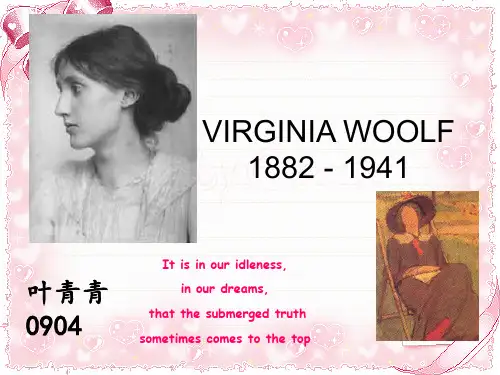
The Haunted Houseby Virginia WoolfWhatever hour you woke there was a door shutting. From room to room they went, hand in hand, lifting here, opening there, making sure--a ghostly couple.‘Here we left it,’ she said. And he added, ‘Oh, but here too!’‘It's upstairs,’ she murmured. ‘And in the garden,’ he whispered. ‘Quietly,’ they said, ‘or we shall wake them.’But it wasn't that you woke us. Oh, no. ‘They're looking for it; they're drawing the curtain,’ one might say, and so read on a page or two.’ Nowthey've found it,’ one would be certain, stopping the pencil on the margin. And then, tired of reading, one might rise and see for oneself, the house all empty, the doors standing open, only the wood pigeons bubbling with content and the hum of the threshing machine sounding from the farm.’ What did I come in here for? What did I want to find?’ My hands were empty. ‘Perhaps it’s upstairs then?’ The apples were in the loft. And so down again, the garden still as ever, only the book had slipped into the grass.But they had found it in the drawing room. Not that one could ever see them. The window panes reflected apples, reflected roses; all the leaves were green in the glass. If they moved in the drawing room, the apple only turned its yellow side. Yet, the moment after, if the door was opened, spread about the floor, hung upon the walls, pendant from the ceiling--what? My hands were empty. The shadow of a thrush crossed the carpet; from the deepest wells of silence the wood pigeon drew its bubble of sound. ‘Safe, safe, safe,’ the pulse of the house beat softly.’ The treasure buried; the room . . .’ the pulse stopped short. Oh, was that the buried treasure?A moment later the light had faded. Out in the garden then? But the trees spun darkness for a wandering beam of sun. So fine, so rare, coolly sunk beneath the surface the beam I sought always burned behind the glass. Death was the glass; death was between us, coming to the woman first, hundreds of years ago, leaving the house, sealing all the windows; the rooms were darkened. He left it, left her, went North, went East, saw the stars turned in the Southern sky; sought the house, found it dropped beneath the Downs.‘Safe, safe, safe,’ the pulse of the house beat gladly. ‘The Treasure yours.’The wind roars up the avenue. Trees stoop and bend this way and that. Moonbeams splash and spill wildly in the rain. But the beam of the lamp falls straight from the window. The candle burns stiff and still. Wandering through the house, opening the windows, whispering not to wake us, the ghostly couple seek their joy.‘Here we slept,’ she says. And he adds, ‘Kisses without number.’‘Waking in the morning--’‘Silver between the trees--’‘Upstairs--’‘In the garden--’‘When summer came--’‘In winter snowtime--’ The doors go shutting far in the distance, gently knocking like the pulse of a heart.Nearer they come, cease at the doorway. The wind falls, the rain slides silver down the glass. Our eyes darken, we hear no steps beside us; we see no lady spread her ghostly cloak. His hands shield the lantern. ‘Look,’ he breathes. ‘Sound asleep. Love upon their lips.’Stooping, holding their silver lamp above us, long they look and deeply. Long they pause. The wind drives straightly; the flame stoops slightly. Wild beams of moonlight cross both floor and wall, and, meeting, stain the faces bent; the faces pondering; the faces that search the sleepers and seek their hidden joy.‘Safe, safe, safe,’ the heart of the house beats proudly. ‘Long years--’ he sighs. ‘Again you found me.’‘Here,’ she murmurs, ‘sleeping; in the garden reading; laughing, rolling apples in the loft. Here we left our treasure--’Stooping, their light lifts the lids upon my eyes. ‘Safe! safe! safe!’ the pulse of the house beats wildly. Waking, I cry ‘Oh, is this your buried treasure? The light in the heart.’。
第一章测试1.Beowulf is an epic of 3182 lines, which is the greatest work of literature ofthe Old English Period.A:错B:对答案:B2.The year 1066 marks the beginning of the Middle English or Anglo-NormanPeriod.A:错B:对答案:B3.Robin Hood is the hero in the collection of 15th-century medieval romances.A:错B:对答案:A4.The Canterbury Tales is a masterpiece by Geoffrey Chaucer, the firstpreeminent English poet in history.A:错B:对答案:B5.The structure of The Canterbury Tales is similar to Boccacio’s Decameron.A:对B:错答案:A6. ( ) refers to a long narrative poem celebrating the great deeds of somelegendary heroes.A:EpicB:LegendC:FableD:Ballad答案:A7.( ) is also known as “head rhyme” or “initial rhyme”.A:AlliterationB:ConsonanceC:AssonanceD:Onomatopoeia答案:A8.Who introduced heroic couplet into England?A:Thomas MaloryB:Alfred the GreatC:Geoffrey ChaucerD:Cynewulf答案:C9.Which of the following works belong to the Old English Period?A:BeowulfB:Morte d’ArthurC:Anglo-Saxon ChronicleD:Christ答案:ACD10.Which of the following literary works come from the Middle English Period?A:The Legend of St. ElenaB:Chanson de RolandC:Piers the PlowmanD:The Ecclesiastical History of England答案:BC第二章测试1.The Faerie Queene, fusing adroitly the strands of legend, fable, and praise ofElizabeth I’s England in iteself, is a masterpiece written by Thomas Wyatt,who introduced sonnet into English poetry.A:对B:错答案:B2.“University Wits” were all graduates from Oxford or Cambridge during the1580s; Christopher Marlowe, Robert Greene, George Peele, Thomas Lodge,Thomas Nash, and Ben Jonson were outstanding representatives of thisschool.A:对B:错答案:B3.Tamburlanine the Great, The Jew of Malta, and The Tragical History of DoctorFaustus are great tragedies written by Christopher Marlowe, the mostprominent figure among the “University Wits.”A:对B:错答案:A4.William Shakespeare had produced 154 sonnets in total, and the first 126sonnets seem to be addressed to a young woman, who possesses extremebeauty.A:错B:对答案:A5.All Shakespeare’s plays take place in England.A:对答案:B6.( ) is a nine-line stanza of eight lines of iambic pentameter plus an iambichexameter.A:Italian sonnetB:Spenserian stanzaC:English sonnetD:Spenserian sonnet答案:B7.Who coined the term “Metaphysical Poets”?A:Andrew MarvellB:Samuel JohnsonC:John DonneD:George Herbert答案:B8.Who is the most popular and most widely respected writer in all Englishliterature?A:John BunyanB:John DonneC:John MiltonD:William Shakespeare答案:D9.Which of the fol lowing adjectives can be used to describe Francis Bacon’sessays?A:freshB:vigorousC:powerfulD:conservative答案:ABC10.Who were dramatists during the Elizabethan Age?A:Thomas NashB:Robert GreeneC:Thomas KydD:Ben Jonson答案:ABCD第三章测试1.Alexander Pope was the representative poet of the neo-classical school, andthe early 18th century has often been named as the Age of Pope.A:对B:错答案:A2.Gulliver’s Travels is the most enduring work by Jonathan Swift, which is asavage satire in the form of a fabulous travelogue.B:错答案:A3.Henry Fielding is regarded as the father of English fiction by Sir Walter Scott,and he had applied first-person narration in his novels.A:错B:对答案:A4.William Blake is renowned now for his Songs of Innocence and Songs ofExperience.A:对B:错答案:A5.Robert Burns wrote in Scottish dialect, and he followed the Scottish songtradition in his poetry.A:错B:对答案:B6.( ) refers to a lyric poem lamenting a dead friend, or a public figure.A:EpicB:OdeC:ElegyD:Sonnet答案:C7.Who defined novel as a genre?A:Henry FieldingB:Samuel JohnsonC:Jonathan SwiftD:Daniel Defoe答案:A8.“Auld Lang Syne” praises ( ).A:friendshipB:freedomC:loveD:patriotism答案:A9.Which of the following are the features of Enlightenment?A:A devotion to harmony, proportion, and balance.B:Profound faith in the powers of human reason.C:Strong belief in imagination.D:Strong belief in the clarity of thought.答案:ABD10.Who are writers of neo-classicism?A:Henry FieldingB:John DydenC:Thomas MoreD:Alexander Pope答案:ABD第四章测试1.The Romantic Age began with the publication of Lyrical Ballads in 1798 andended with the death of Sir Walter Scott in 1832.A:对B:错答案:A2.The romantic poets paid great attention on reason or rationality in theirpoetry.A:错B:对答案:A3.In the preface for the first edition of Lyrical Ballads, Wordsworth put forwardhis principles of poetry.A:对B:错答案:B4.The Revolt of Islam is P. B. Shelley’s first long poem of importance.A:错B:对答案:A5.Jane Austen is the first important English woman novelist, who wrotealtogether six novels.A:对B:错答案:A6.Who is the author of Biographia Literaria?A:William WordsworthB:S. T. ColeridgeC:Robert SoutheyD:P. B. Shelley答案:B7.Which of the following novel by Scott has its spatial setting in England?A:The TalismanB:IvanhoeC:WaverleyD:Quentin Durward答案:B8.Which of the following are ideals advocated by the French Revolution?A:equalityB:reasonC:libertyD:fraternity答案:ACD9.Which of the following are characters from Prometheus Unbound?A:PantheaB:DemogorgonC:Eternal LoveD:Africa答案:ABC10.Which work made Byron famous?A:The Revolt of IslamB:A Defense of PoetryC:Childe Harold’s PilgrimageD:Don Juan答案:C第五章测试1.The critical realists criticised the capitalist social system from a proletarianpoint of view.A:对B:错答案:B2.Alfred Tennyson, Robert Browning, and John Ruskin were all eminent figuresamong the Victorian poets.A:对B:错答案:B3.Dickens took the French Revolution as the background of A Tale of TwoCities, and the two cities are Paris and London.A:错B:对答案:B4.Wuthering Heights, the masterpiece of Emily Brontë, narrates the tragic lovestory of a governess.A:错B:对答案:A5.Thomas Hardy is one of the representatives of English critical realism in theearly part of the Victorian period.A:错B:对答案:A6.Which is the most popular form of all the literary art during the Victorianperiod?A:fictionB:dramaC:proseD:poetry答案:A7.Who wrote the bewitching Sherlock Holmes cycle of detective stories?A:Robert Louis StevensonB:Wilkie CollinsC:Lewis CarrollD:Conan Doyle答案:D8.What is an archetypal Dickensian hero like?A:An adult.B:An orphan.C:A boy.D:A girl.答案:B9.Which of the following are spatial settings in Jane Eyre?A:ThornfieldB:GatesheadC:LowoodD:Ferndean答案:ABCD10.Which of the following characters are included in The Importance of BeingEarnest?A:GwendolynB:AlgernonC:CecilyD:Jack Worthing答案:ABCD第六章测试1.Realism and modernism coexisted in the 20th-century British literature.A:对B:错答案:A2.The theoretical base of modernism is rationalism.A:错B:对答案:A3.Sons and Lovers, an autobiographical novel by D. H. Lawrence, deals with astory of a father’s dominant and debilitating love over the sons.A:错B:对答案:A4.The Waste Land, T. S. Eliot’s masterpiece, uses the past as a ya rdstick tomeasure the present and underscore what is missing from the present.A:对B:错答案:A5.W. B. Yeats played a major role in the Irish literay revival.A:对B:错答案:A6.Who wrote The Time Machine?A:H. G. WellsB:Arnold BennettC:Rudyard KiplingD:John Galsworthy答案:A7.Who won the Nobel Pize in 1923?A:W. B. YeatsB:T. S. EliotC:Virginia WoolfD:James Joyce答案:A8.Which of the following work suggests Eliot had turned conservative?A:Murder in the CathedralB:The Cocktail PartyC:Ash WednesdayD:The Confidential Clerk答案:C9.Who were “Edwardians” as termed by Woolf?A:Arnold BennettB:H. G. WellsC:John GalsworthyD:E. M. Forster答案:ABC10.Which of the following poems are written by Yeats?A:“The Second Coming”B:“Gerontion”C:“Sailing to Byzantium”D:The Waste Land答案:AC。
How Should One Read a Book? 应该怎样读书_儿童英汉双语故事How Should One Read a Book?by Virginia Woolf (1882-1941) from The Second Common ReaderBorn in England, Virginia Woolf was the daughter of Leslie Stephen, a well-known scholar. She was educated primarily at home and attributed her love of reading to the early and complete access she was given to her fathers library. With her husband, Leonard Woolf, she founded the Hogarth Press and became known as member of the Bloomsbury group of intellectuals, which included economist John Maynard Keynes, biographer Lytton Strachey, novelist E. M. Forster, and art historian Clive Bell. Although she was a central figure in London literary life, Woolf often saw herself as isolated from the mains stream because she was a woman. Woolf is best known for her experimental, modernist novels, including Mrs. Dalloway(1925) and To the Lighthouse(1927) which are widely appreciated for her breakthrough into a new mode and technique--the stream of consciousness. In her diary and CRItical essays she has much to say about women and fiction. Her 1929 book A Room of Ones Own documents her desire for women to take their rightful place in literary history and as an essayist she has occupied a high place in 20thcentury literature. The common Reader (1925 first series; 1932 second series) has acquired classic status. She also wrote short stories and biographies. Professions for Women taken from The collected Essays V ol 2. is originally a paper Woolf read to the Womens Service League, an organization for professional women in London.In the first place, I want to emphasize the note of interrogation at the end of my title. Even if I could answer the question for myself, the answer would apply only to me and not to you. The only advice, indeed, that one person can give another about reading is to take no advice, to follow your own instincts, to use your own reason, to come to your own conclusions. If this is agreed between us, then I feel at liberty to put forward a few ideas and suggestions because you will not allow them to fetter that independence which is the most important quality that a reader can possess. After all, what laws can be laid down about books? The battle of Waterloo[1] was certainly fought on a certain day; but is Hamlet a better play than Lear? Nobody can say. Each must decide that question for himself. To admit authorities, however heavily furred and gowned, into our libraries and let them tell us how to read, what to read, what value to place on what we read, is to destroy the spirit of freedom which is the breath of those sanctuaries. Everywhere else we may be bound by laws and conventionsthere we have none.But to enjoy freedom, if the platitude is pardonable, we have ofcourse to control ourselves. We must not squander our powers, helplessly and ignorantly, squirting half the house in order to water a single rose-bush; we must train them, exactly and powerfully, here on the very spot. This, it may be, is one of the first difficulties that faces us in a library. What is the very spot? There may well seem to be nothing but a conglomeration and huddle of confusion. Poems and novels, histories and memoirs, dictionaries and blue-books; books written in all languages by men and women of all tempers, races, and ages jostle each other on the shelf. And outside the donkey brays, the women gossip at the pump, the colts gallop across the fields. Where are we to begin? How are we to bring order into this multitudinous chaos and get the deepest and widest pleasure from what we read?It is simple enough to say that since books have classes--fiction, biography, poetry--we should separate them and take from each what it is right that each should give us. Yet few people ask from books what books can give us. Most commonly we come to books with blurred and divided minds, asking of fiction that it shall be true, of poetry that it shall be false, of biography that it shall be flattering, of history that it shall enforce our own prejudices. If we could banish all such preconceptions when we read, that would be an admirable beginning. Do not dictate to your author; try to become him. Be his fellow-worker and accomplice. If you hang back, and reserve and CRIticize at first, you are preventing yourself fromgetting the fullest possible value from what you read. But if you open your mind as widely as possible, the signs and hints of almost imperceptible fineness, from the twist and turn of the first sentences, will bring you into the presence of a human being unlike any other. Steep yourself in this, acquaint yourself with this, and soon you will find that your author is giving you, or attempting to give you, something far more definite. The thirty-two chapters of a novelif we consider how to read a novel first--are an attempt to make something as formed and controlled as a building: but words are more impalpable than bricks; reading is a longer and more complicated process than seeing. Perhaps the quickest way to understand the elements of what a novelist is doing is not to read, but to write; to make your own experiment with the dangers and difficulties of words. Recall, then, some event that has left a distinct impression on youhow at the corner of the street, perhaps, you passed two people talking.A tree shook; an electric light danced; the tone of the talk was comic, but also tragic; a whole vision; an entire conception, seemed contained in that moment.But when you attempt to reconstruct it in words, you will find that it breaks into a thousand conflicting impressions. Some must be subdued; others emphasized; in the process you will lose, probably, all grasp upon the emotion itself. Then turn from your blurred and littered pages to the opening pages of some great novelistDefoe, Jane Austen, or Hardy. Nowyou will be better able to appreciate their mastery. It is not merely that we are in the presence of a different personDefoe, Jane Austen, or Thomas Hardybut that we are living in a different world. Here, in Robinson Crusoe, we are trudging a plain high road; one thing happens after another; the fact and the order of the fact is enough. But if the open air and adventure mean everything to Defoe they mean nothing to Jane Austen. Hers is the drawing-room, and people talking, and by the many mirrors of their talk revealing their characters. And if, when we have accustomed ourselves to the drawing-room and its reflections, we turn to Hardy, we are once more spun around. The other side of the mind is now exposedthe dark side that comes uppermost in solitude, not the light side that shows in company. Our relations are not towards people, but towards Nature and destiny. Yet different as these worlds are, each is consistent with itself. The maker of each is careful to observe the laws of his own perspective, and however great a strain they may put upon us they will never confuse us, as lesser writers so frequently do, by introducing two different kinds of reality into the same book. Thus to go from one great novelist to anotherfrom Jane Austen to Hardy, from Peacock[2] to Trollope,[3] from Scott to Meredith[4]is to be wrenched and uprooted; to be thrown this way and then that. To read a novel is a difficult and complex art. You must be capable not only of great finesse of perception, but of great boldness of imagination if you are going to make use of allthat the novelistthe great artistgives you.* * * *We have only to comparewith those words the cat is out of the bag, and the true complexity of reading is admitted. The first process, to receive impressions with the utmost understanding, is only half the process of reading; it must be completed, if we are to get the whole pleasure from a book, by another. We must pass judgment upon these multitudinous impressions; we must make of these fleeting shapes one that is hard and lasting. But not directly. Wait for the dust of reading to settle; for the conflict and the questioning to die down; walk, talk, pull the dead petals from a rose, or fall asleep. Then suddenly without our willing it, for it is thus that Nature undertakes these transitions, the book will return, but differently. It will float to the top of the mind as a whole. And the book as a whole is different from the book received currently in separate phrases. Details now fit themselves into their places. We see the shape from start to finish; it is a barn, a pig-sty, or a cathedral. Now then we can compare book with book as we compare building with building. But this act of comparison means that our attitude has changed; we are no longer the friends of the writer, but his judges; and just as we cannot be too sympathetic as friends, so as judges we cannot be too severe. Are they not CRIminals, books that have wasted our time and sympathy; are they not the most insidious enemies of society, corrupters, defilers, the writersof false books, faked books, books that fill the air with decay and disease? Let us then be severe in our judgments; let us compare each book with the greatest of its kind. There they hang in the mind the shapes of the books we have read solidified by the judgments we have passed on themRobinson Crusoe, Emma, The Return of the Native. Compare the novels with theseeven the latest and least of novels has a right to be judged with the best. And so with poetrywhen the intoxication of rhythm has died down and the splendour of words has faded a visionary shape will return to us and this must be compared with Lear, with Phedre,[5] with The Prelude;[6] or if not with these, with whatever is the best or seems to us to be the best in its own kind. And we may be sure that the newness of new poetry and fiction is its most superficial quality and that we have only to alter slightly, not to recast, the standards by which we have judged the old.It would be foolish, then, to pretend that the second part of reading, to judge, to compare, is as simple as the firstto open the mind wide to the fast flocking of innumerable impressions. To continue reading without the book before you, To hold one shadow-shape against another, to have read widely enough and with enough understanding to make such comparisons alive and illuminatingthat is difficult; it is still more difficult to press further and to say, Not only is the book of this sort, but it is of this value; here it fails; here it succeeds; this is bad; that is good. To carry out thispart of a readers duty needs such imagination, insight, and learning that it is hard to conceive any one mind sufficiently endowed; impossible for the most self-confident to find more than the seeds of such powers in himself. Would it not be wiser, then, to remit this part of reading and to allow the critics, the gowned and furred authorities of the library, to decide the question of the books absolute value for us? Yet how impossible! We may stress the value of sympathy; we may try to sink our own identity as we read. But we know that we cannot sympathise wholly or immerse ourselves wholly; there is always a demon in us who whispers, I hate, I love, and we cannot silence him. Indeed, it is precisely because we hate and we love that our relation with the poets and novelists is so intimate that we find the presence of another person intolerable. And even if the results are abhorrent and our judgments are wrong, still our taste, the nerve of sensation that sends shocks through us, is our chief illuminating; we learn through feeling; we cannot suppress our own idiosyncrasy without impoverishing it. But as time goes on perhaps we can train our taste; perhaps we can make it submit to some control. When it has fed greedily and lavishly upon books of all sortspoetry, fiction, history, biographyand has stopped reading and looked for long spaces upon the variety, the incongruity of the living world, we shall find that it is changing a little; it is not so greedy, it is more reflective. It will begin to bring us not merely judgments on particular books, but it will tell us thatthere is a quality common to certain books. Listen, it will say, what shall we call this? And it will read us perhaps Lear and then perhaps Agamenon[7] in order to bring out that common quality. Thus, with our taste to guide us, we shall venture beyond the particular book in search of qualities that group books together; we shall give them names and thus frame a rule that brings order into our perceptions. We shall gain a further and a rarer pleasure from that discrimination. But as a rule only lives when it is perpetually broken by contact with the books themselvesnothing is easier and more stultifying than to make rules which exist out touch with facts, in a vacuumnow at least, in order to steady ourselves in this difficult attempt, it may be well to turn to the very rare writers who are able to enlighten us upon literature as an art. Coleridge[8] and Dryden[9] and Johnson,[10] in their considered criticism, the poets and novelists themselves in their considered sayings are often surprisingly relevant; they light up and solidity the vague ideas that have been tumbling in the misty depths of our minds. But they are only able to help us if we come to them laden with questions and suggestions won honestly in the course of our own reading. They can do nothing for us if we herd ourselves under their authority and lie down like sheep in the shade of a hedge. We can only understand their ruling when it comes in conflict with our own and vanquishes it.If this is so, if to read a book as it should be read calls for the rarestqualities of imagination, insight, and judgment, you may perhaps, conclude that literature is a very complex art and that it is unlikely that we shall be able, even after a lifetime of reading, to make any valuable contribution to its criticism. We must remain readers; we shall not put on the further glory that belongs to those rare beings who are also critics. But still we have our responsibilities as readers and even our importance. The standards we raise and the judgments we pass steal into the air and become part of the atmosphere which writers breathe as they work. An influence is created which tells upon them even if it never finds its way into print. And that influence, if it were well instructed, vigorous and individual and sincere, might be of great value now when criticism is necessarily in abeyance; when books pass in review like the procession of animals in a shooting gallery, and the critic has only one second in which to load and aim and shoot and may well be pardoned if he mistakes rabbits for tigers, eagles for bar-door fowls, or misses altogether and wastes his shot upon some peaceful sow grazing in a further field. If behind the erratic gunfire of the press the author felt that that there was another kind of criticism, the opinion of people reading for the love of reading, slowly and uNPRofessionally, and judging with great sympathy and yet with great severity, might this not improve the quality of his work? And if by our means books were to become stronger, richer, and more varied, that would be an end worth reaching.Yet who reads to bring about an end however desirable? Are there not some pursuits that we practice because they are good in themselves, and some pleasures that are final? And is not this among them? I have sometimes dreamt, at least, that when the Day of Judgment dawns and the great conquerors and lawyers and statesmen come to receive their rewardstheir crowns, their laurels, their names carved indelibly upon imperishable marblethe Almighty will turn to Peter[11] and will say, not without a certain envy when He sees us coming with our books under our arms, Look, these need no reward. We have nothing to give them here. They have loved reading.Questions for Comprehension and Consideration:1. The title of the essay gives a sense of offering advice on reading and the author begins her essay by saying In the first place, I want to emphasize the note of interrogation at the end of my title. Why does the author start her essay in this way and what does she really want to point out in her first paragraph which serves as her starting point when she offers ideas and suggestions on reading.2. How do you understand the authors idea of Do not dictate to your author; try to become him. Be his fellow-worker and accomplice in paragraph3. How does your reading experience agree or disagree with the authors advice?3. Virginia Woolf says the quickest way to understand the elementsof what a novelist is doing is not to read, but to write; and she also gives an example to support it. What do you think of the example? Have you ever had such experience of experimenting with dangers and difficulties of words ? If you have how do you comment your experience?4. The author mentions three writers in paragraph 4 and points out that although they depict things totally different they share one same important element. What is it? Read at least one novel of each writer mentioned and try to understand the different worlds the authors created and see whether you agree to the comment Virginia Woolf made or not.5. What is the true complexity of reading and what are the reading processes Virginia Woolf depicts? How do the processes agree or disagree to your reading experience?6. In the difficult process of reading the author advises us to read some very rare writers who are able to enlighten us upon literature of art. To what extent and on what circumstance they are able to help us?7. In what sense does Virginia Woolf think that common readers have responsibilities and importance in raising the standards and the judgment of reading?8. How do you feel the authors rhetoric question Are there not some pursuits that we practice because they are good in themselves, and is not this (reading) among them? Write a passage with concrete examples to show your true understanding of it.-------------------------------------------------------------------------------- 注释:[1] the battle of Waterloo Waterloo is a town in Belgium, the place where Napoleon Bonaparte(17691821) and his army was totally defeated.[2] Thomas Love Peacock (1785--1866),British novelist and poet.[3] Anthony Trollope (181582), British novelist.[4] George Meredith(1828--1909),British novelist and poet.[5] Phedre French tragic poet Jean Racines(16391699) works.[6] The Prelude British poet William Wordsworths(17701850) long poem.[7] Agamenon The ancient Greece great tragic poet Aischulos(520 BC456BC) works.[8] Samuel Taylor Coleridge(17721834) British romantic poet.[9] John Dryden(16311700) British poet and critic.[10] Samuel Johnson(17091784) British writer.[11] Peter one of the twelve disciple of Jesus Christ.应该怎样读书弗吉尼亚伍尔夫首先我要特别提醒读者注意本文标题后面的问号,即便我能够回答这个问题,答案或许也只适合我自己而并不适合你。
Virginia Woolf 1882 - 1941Virginia Woolf was born Adeline Virginia Stephen in London and educated at home by her father, the biographer Sir Leslie Stephen. She suffered a number of early shocks, including sexual abuse by her half-brother and the death of her mother when she was in her teens. Throughout her life she was subject to mental breakdowns of varying intensity.In 1905, after her father's death, Woolf and her artist sister, Vanessa, lived with their 2 brothers in a house in Bloomsbury which became the headquarters of the so-called Bloomsbury Group. This collection of artists, writers and intellectuals, generally modernist in outlook, were chiefly united by a strong reaction against the preceding Victorian Age. The group included, amongst others, writer E M Forster, biographer Lytton Strachey andpainters Vanessa Bell and Duncan Grant.In 1912, Woolf married a member of the group, the political theorist Leonard Woolf, with whom she founded the Hogarth Press in 1917. After publishing 2 realistic novels, she developed a more experimental approach with her third book, Jacob's Room(1922), based on the life of her brother Toby, who had died tragically in 1906.Her next novel, Mrs Dalloway(1925), presenting the thoughts and inner lives of several groups of people in the course of a single day, broke new ground with the stream of consciousness technique pioneered by James Joyce in Ulysses (1922). To the Lighthouse(1927) showed great technical mastery, with a form tightly organized through the use of recurrent images and a restricted time frame. In The Waves (1931), she again recorded the stream of consciousness of her creations, invitingthe reader to inhabit the minds of her 6 characters from childhood to old age.In 1928, Woolf published a historical fantasy, Orlando, an imaginative analysis of gender, identity and creativity. "In every human being," she later wrote, "a vacillation from one sex to the other takes place". Covering a huge time span, Orlando also made use of elements taken from the life and family history of her friend and lover Vita Sackville-West.In her long essay A Room of One's Own (1929), Woolf turned her attention to the cause of women's rights, especially the obstacles that have hindered women writers. Most literature, she claimed, had been "made by men out of their own needs for their own uses".Woolf wrote some fine criticism, notably The Common Reader(1925), and her posthumously published diaries and correspondence shed much light on her lifeand work. Dogged throughout her life by a form of hypomania or manic depression, she committed suicide by drowning in 1941.KEY WORKS INCLUDE:Jacob's Room (1922)Mrs Dalloway (1925)The Common Reader (1925)To the Lighthouse (1927)Orlando (1928)A Room of One's Own (1929)The Waves (1931)Between the Acts (1941)弗吉尼亚·伍尔芙(Virginia Woolf,或译弗吉尼亚·伍尔夫,1882年1月25日-1941年3月28日)。
英国女作家,被誉为二十世纪现代主义与女性主义的先锋。
两次世界大战期间,她是伦敦文学界的核心人物,同时也是布卢姆茨伯里派(Bloomsbury Group)的成员之一。
最知名的小说包括《戴洛维夫人》(Mrs. Dalloway)、《灯塔行》(Tothe Lighthouse)、《雅各的房间》(Jakob's Room)。
弗吉尼亚·伍尔芙(Virginia Woolf?1882年1月25日—1941年3月28日)。
英国女作家,批判家,意识流小说的代表人物之一。
《墙上的斑点》是她第一篇典型的意识流作品。
(被认为是二十世纪现代主义与女性主义的先锋之一。
在两次世界大战期间,伍尔芙是伦敦文学界的核心人物,她同时也是布卢姆茨伯里派(Bloomsbury Group)的成员之一。
其最知名的小说包括《戴洛维夫人》(Mrs. Dalloway)、《灯塔行》(To the Lighthouse)、《雅各的房间》(Jakob's Room)。
复杂的家庭背景,这个9口之家、两群年龄与性格不合的子女经常发生一些矛盾与冲突。
而伍尔芙同母异父的两位兄长对她的伤害给她留下了永久的精神创伤。
1895年母亲去世之后,她第一次精神崩溃。
后来她在自传《存在的瞬间》(Moments of Being)中道出她和姐姐瓦内萨·贝尔(Vanessa Bell)曾遭受同母异父的哥哥乔治和杰瑞德·杜克沃斯(Gerald Duckworth)的性侵犯。
昆汀贝尔认为,弗吉尼娅的神经错乱和自杀前的幻听,和弗吉尼亚少女时期遭受的精神创伤导致无法愈合的伤口有关。
事实上,弗吉尼亚成人后非常厌恶性生活,更不愿生儿育女,对于同性的依恋甚至一度成为她感情世界里的重心。
诚然对于布鲁姆斯伯里文化圈里复杂多变的情感关系,并不能以常人的眼光等闲看待,即便如此,弗吉尼亚的情感状态依然被认为是出格的。
她不可救药地依恋着姐姐瓦奈萨,甚至采用一种最为出人意料的极端方式——和姐夫克莱夫调情,并以其作为自己的感情替身或者说傀儡。
弗吉尼亚和瓦奈萨,在布鲁姆斯伯里文化圈,始终是被关注的焦点,不论生前还是死后,除了她们的艺术才华,还有她们的生活隐私。
1904年她父亲莱斯利·斯蒂芬爵士(Sir Leslie Stephen,著名的编辑和文学批评家)去世之后,她和瓦内萨迁居到了布卢姆斯伯里(Bloomsbury)。
后来以她们和几位朋友为中心创立了布卢姆茨伯里派文人团体。
她在1905年开始职业写作生涯,刚开始是为《泰晤士报文学增刊》撰稿。
在某种程度上说,弗吉尼亚是上帝的弃儿,母亲、父亲相继病逝,是她难以承受的打击。
她的小说《达洛威夫人》中即充满了对病态幻觉的真实生动的描绘,可以说是她的精神写照。
弗吉尼亚不幸的生活经历,使她如含羞草一般敏感,又如玻璃般的易碎,她是优雅的,又是神经质的,一生都在优雅和疯癫之间游走。
有人这样描述弗吉尼亚,准确地把握住她的精神气质:“她的记忆有着隐秘的两面——一面澄明,一面黑暗;一面寒冷,一面温热;一面是创造,一面是毁灭;一面铺洒着天堂之光,一面燃烧着地狱之火。
”1915年,她的第一部小说《远航》出版,其后的作品都深受评论界和读者喜爱。
大部分作品都是由自己成立的“贺加斯岀版”推岀。
伍尔夫夫妇搬到Hogarth House. 1917 伍尔夫夫妇买下一架二手的印刷机,在家中的地下室建立了霍加斯(Hogarth)出版社。
(该出版社后来出版了包括艾略特、凯瑟琳·曼斯菲尔德、弗洛依德在内的作家作品,并且出版了伍尔夫的所有作品。